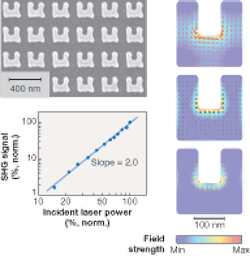NONLINEAR OPTICAL MATERIALS: Metamaterial achieves second-harmonic generation
Optical metamaterials are the subject of much research as a result of their surprising properties of wave propagation. Negative refraction in metamaterials, as well as negative phase and group velocity, have been demonstrated in the 1.5 µm wavelength region, while negative permeability (one requirement, although not the only requirement, for negative refraction to occur) has been shown in the visible.1, 2
Now, researchers at the Universität Karlsruhe and the Institut für Nanotechnologie, Forschungszentrum Karlsruhe in der Helmholtz-Gemeinschaft (both of Karlsruhe, Germany) have created a metamaterial that produces second-harmonic generation at a 1.5 µm wavelength. The effect arises as a result of the negative magnetic permeability of the metamaterial.3
The refractive index (n) of a metamaterial “chooses” the negative solution of the well-known equation n2 = εµ if both the electric permittivity (ε) and the magnetic permeability (µ) are negative.4 Metals show negative ε; however, their µ equals 1. But a negative magnetic permeability can be achieved by creating a magnetic metamaterial composed, for example, of densely packed microscopic so-called LC (inductive-capacitive) circuits. In a popular optical-metamaterial design, the inductance is formed by a conductive ring; one slit in this ring gives rise to a capacitance. For frequencies of the incoming light slightly exceeding the LC resonance frequency, the resulting strong local magnetic oscillating dipoles can overcompensate the external magnetic field of the light wave. This situation corresponds to a strong diamagnetic with a negative magnetic permeability. Nonlinear responses of such LC circuits can be expected because the energy density becomes locally extremely high.5
The researchers fabricated gold split-ring resonators of different diameters (falling in the range 0.22 to 0.48 µm) deposited on a glass substrate coated with indium tin oxide (see figure). They focused a beam of linearly polarized 120-fs-long pulses from an optical parametric oscillator onto the array of resonators at normal incidence at a spot size of 50 µm diameter; the average power reached 50 mW, while the pulse peak intensities were in the range of 100 MW/cm2. In transmission, the fundamental wavelength was blocked and the second harmonic passed through an analyzing polarizer onto a photomultiplier.
First, the resonance response as a function of polarization and detuning was studied, revealing the expected LC resonance as well as an additional Mie-type resonance. Then, tuning the laser to the LC resonance and aligning the polarization of the incident wave parallel to the ring-capacitor field, optimal frequency doubling was observed. As expected for a second-order nonlinear response, the intensity showed a slope of two in a double-logarithmic plot as a function of incident laser power. The authors described the frequency doubling as the immediate consequence of the transverse second-harmonic part of the Lorentz-force field that becomes especially active in the two inner bends of the U-shaped coil, as shown by numerical calculations.
The experiments demonstrate for the first time that artificial metamaterials can be the basis of a new approach to nonlinear optics, showing potential for the design of new optical devices using micro- or nanoscopic functional cells for “µ engineering”; this may become complementary to the “ε engineering” practiced already in photonic crystals.
REFERENCES
1. G. Dolling et al., Science, 12, 5775 (2006).
2. A.N. Grigorenko et al., Nature 438 (2005).
3. M.W. Klein et al., Science, 313 (2006).
4. V.G. Veselago, Sov. Phys. Usp. 10 (1968).
5. J.B. Pendry et al., IEEE Trans. on Microwave Theory and Techniques 47(11) (1999).
About the Author
Uwe Brinkmann
Contributing Editor, Germany
Uwe Brinkmann was Contributing Editor, Germany, for Laser Focus World.
